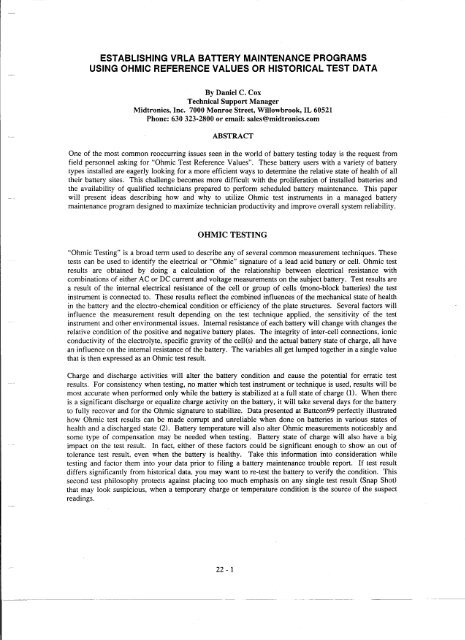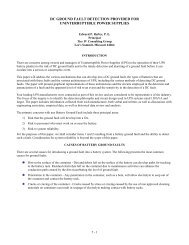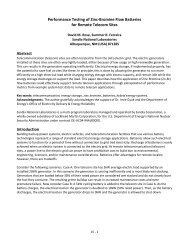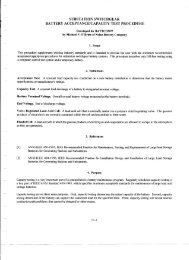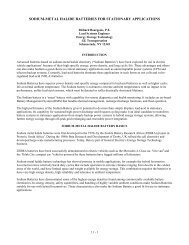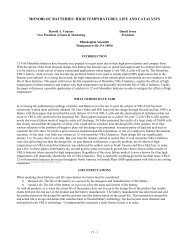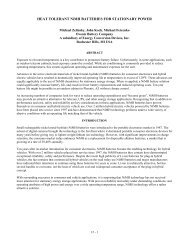ESTABLISHING VRlA BATTERY MAINTENANCE PROGRAMS ...
ESTABLISHING VRlA BATTERY MAINTENANCE PROGRAMS ...
ESTABLISHING VRlA BATTERY MAINTENANCE PROGRAMS ...
Create successful ePaper yourself
Turn your PDF publications into a flip-book with our unique Google optimized e-Paper software.
<strong>ESTABLISHING</strong> <strong>VRlA</strong> <strong>BATTERY</strong> <strong>MAINTENANCE</strong> <strong>PROGRAMS</strong><br />
USING OHMIC REFERENCE VALUES OR HISTORICAL TEST DATA<br />
By Daniel C. Cox<br />
Technical Support Manager<br />
Midtronics, Inc. 7000 Monroe Street, Willowbrook, IL 60521<br />
Phone: 630 323-2800 or email: sales@midtronics.com<br />
One of the most common reoccurring issues seen in the world of battery testing today is the request from<br />
field personnel asking for "Ohmic Test Reference Values". These battery users with a variety of battery<br />
types installed are eagerly looking for a more efficient ways to determine the relative state of health of all<br />
their battery sites. This challenge becomes more difficult with the proliferation of installed batteries and<br />
the availability of qualified technicians prepared to perform scheduled battery maintenance. This paper<br />
will present ideas describing how and why to utilize Ohmic test instruments in a managed battery<br />
maintenance program designed to maximize technician productivity and improve overall system reliability.<br />
"Ohmic Testing" is a broad term used to describe any of several common measurement techniques. These<br />
tests can be used to identify the electrical or "Ohmic" signature of a lead acid battery or cell. Ohmic test<br />
results are obtained by doing a calculation of the relationship between electrical resistance with<br />
combinations of either AC or DC current and voltage measurements on the subject battery. Test results are<br />
a result of the internal electrical resistance of the cell or group of cells (mono-block batteries) the test<br />
instrument is connected to. These results reflect the combined influences of the mechanical state of health<br />
in the battery and the electro-chemical condition or efficiency of the plate structures. Several factors will<br />
influence the measurement result depending on the test technique applied, the sensitivity of the test<br />
instrument and other environmental issues. Internal resistance of each battery will change with changes the<br />
relative condition of the positive and negative battery plates. The integrity of inter-cell connections, ionic<br />
conductivity of the electrolyte, specific gravity of the cell(s) and the actual battery state of charge, all have<br />
an influence on the internal resistance of the battery. The variables all get lumped together in a single value<br />
that is then expressed as an Ohmic test result.<br />
Charge and discharge activities will alter the battery condition and cause the potential for erratic test<br />
results. For consistency when testing, no matter which test instrument or technique is used, results will be<br />
most accurate when performed only while the battery is stabilized at a full state of charge (1). When there<br />
is a significant discharge or equalize charge activity on the battery, it will take several days for the battery<br />
to fully recover and for the Ohmic signature to stabilize. Data presented at Battcon99 perfectly illustrated<br />
how Ohmic test results can be made corrupt and unreliable when done on batteries in various states of<br />
health and a discharged state (2). Battery temperature will also alter Ohmic measurements noticeably and<br />
some type of compensation may be needed when testing. Battery state of charge will also have a big<br />
impact on the test result. In fact, either of these factors could be significant enough to show an out of<br />
tolerance test result, even when the battery is healthy. Take this information into consideration while<br />
testing and factor them into your data prior to filing a battery maintenance trouble report. If test result<br />
differs significantly from historical data, you may want to re-test the battery to verify the condition. This<br />
second test philosophy protects against placing too much emphasis on any single test result (Snap Shot)<br />
that may look suspicious, when a temporary charge or temperature condition is the source of the suspect<br />
readings.
Another way to state this case is that if the battery is not at full-charge equilibrium, you should expect its<br />
internal resistance to be changing and therefore, the Ohmic signature of the battery will be changing as<br />
well. The best suggestion to help guarantee accurate test results would be to revisit the site and re-test<br />
when you are confident the condition of the batteries has stabilized. This is also an issue in some older<br />
Photovoltaic applications where low state of charge can be a common problem.<br />
All Ohmic battery test instruments employ one of the following measurement techniques:<br />
1. DC Resistance is measured by applying a load across the cell or cells and measuring the resulting step<br />
change in voltage and current. By dividing the change in voltage by the change in current, DC<br />
resistance can be calculated using Ohms Law and results are expressed in micro-ohms.<br />
2. Impedance testing is done by passing an AC current at a specific frequency and amplitude through the<br />
battery and then measuring the AC voltage drop between the positive and negative battery terminals.<br />
Here again the results are calculated using Ohms Law and the results are expressed in micro ohms.<br />
3. Conductance measurements, sometimes called acceptance measurements, are preformed by applying<br />
an AC voltage of a known frequency and amplitude across the cell or cells and observing the current<br />
that flows as the result. Conductance is the ratio of the AC current that is in-phase with the AC voltage<br />
compared to the amplitude of the AC voltage producing the current. Test results are expressed in<br />
Siemens or Mhos which is Ohms spelled backward.<br />
AC conductance is regarded as being the inverse of AC impedance.<br />
Ohmic test instruments will utilize one of the aforementioned processes to calculate their results. Each of<br />
these basic test methods has been investigated extensively in independent laboratory research (3). This<br />
data show the techniques all have a reasonable ability to identify suspect cells which are most likely to have<br />
low capacities. A variety of testers are commercially available from several vendors, with thousands of<br />
units in use around the world today. Although differing in their specific operation, each test techniques<br />
mentioned uses the application of "Ohms Law" to calculate the resistive characteristic of a battery. This is<br />
where the name "Ohmic Tester" comes from. The simple rule of thumb for a lead/acid cell is - - the higher<br />
the internal resistance or, the lower the measured conductance of a cell, the lower the expected capacity or<br />
discharge performance from that cell. In terms of which type of instrument is best for any specific<br />
application, it is up to each user to identify which product or products satisfy their own application needs.<br />
It is reasonable to suggest that most modern test instruments will provide a viable option to your battery<br />
test and maintenance programs when used in accordance with the manufacturers' published operating<br />
instructions and effective operating range.<br />
Capacity testing or service testing a battery usually means the battery system must be taken out of service<br />
at least for the duration of the discharge test and recharge time. Being both portable and designed for use<br />
outside the battery laboratory, Ohmic test instruments offer the potential for huge labor and cost savings<br />
when compared to invasive capacity testing. Ohmic testing can usually be performed quickly while the<br />
battery is in service. These tests will point out potential problems that won't be detected with just a cell<br />
voltage check or visual inspection. Ohmic battery testing prior to capacity testing is a great way to gain an<br />
additional margin of safety. The customer doesn't have to risk capacity testing a battery that could break<br />
down under full load conditions.<br />
Operators with battery systems should have maintenance policies or procedures in place consistent with<br />
their battery manufacturers' operating instructions, IEEE installation and maintenance guidelines or similar<br />
information, to guarantee batteries are being operating properly. For anyone not familiar with IEEE Battery<br />
Standards, a list of available documents can be obtained from their web site at http://standards.ieee.org.<br />
These are excellent tutorials covering information on safety, maintenance schedules and other factors to<br />
guide users establishing a battery maintenance program.
When reference numbers are talked about, they relate to what the "electrical signature" of a specific battery<br />
type will be when it is new, fully charged, healthy and delivered for installation. That electrical signature<br />
for both DC resistance and AC impedance test results are expressed in micro Ohms, while conductance test<br />
results are given in either Mhos or Siemens. It is important to understand that a single exact reference<br />
value is almost irrelevant because of several factors. Figure 2 shows the conductance results observed on<br />
one group of new batteries ready for customer delivery. These data samples are consistent with what is<br />
observed on batteries from a number of manufacturers after end-of-line testing, just before shipping. The<br />
measured conductance in this sample is not exact, but there is an obvious pattern. Ohmic test values on<br />
VRLA cells will change after cells have been in service for three or four months. The recombination<br />
process inside the VRLA cell does not fully develop until they have been placed into float service. It may<br />
be appropriate to use two Ohmic reference numbers for a battery type. One will be used for acceptance<br />
screening prior to installation and a second value representing an optimized value for installed cells where<br />
the recombination process has fully evolved.<br />
There are two primary answers to this question. The first source for battery Ohmic reference data can come<br />
from anyone with an Ohmic test instrument. This works particularly well for cells that are installed but no<br />
longer in production. There are no new cells to obtain data from, you can only compare them to each other<br />
or other cells from the same manufacturer with a similar service history. Simply test the batteries and<br />
document the results, you will have a benchmark to work with in the future. If you take this information<br />
directly from the subject batteries, you will also eliminate any confusion resulting from variations found in<br />
their manufacture or their service history. Testing new cells prior to installation is the ideal way to start<br />
your database. However, even on an existing system, all you need is the test equipment and time to<br />
complete the testing and your state-of-health database is underway.<br />
The second source for battery reference data can come directly from the battery manufacturer. The<br />
manufacturers have all the batteries they need to get the reliable information their customers want. Because<br />
customers are asking battery manufacturers for reference data, many have already begun providing this<br />
information. The published information to date has been some of the typical conductive or resistive<br />
signatures measured on the most common battery models. FlAMM Energy has provided a range of battery<br />
resistance and conductance test values for many of their new batteries (5). They have further presented<br />
conductance and resistance values, which may indicate the cells are nearing the "end of their serviceable<br />
life." Similarly, the Dynasty Division of C & D Battery (formerly part of lCI) provides a range of<br />
impedance and conductance values for their most common stationary battery types (6). Other<br />
manufacturers are in the process of developing similar information. Accurate Ohmic reference numbers<br />
can be acquired by testing a representative sample of healthy new batteries in a uniform state of charge.<br />
The larger the sample the more definitive the test result. (thirty or more tests on any cell type are generally<br />
a reasonable number to begin with). It is a good idea to match the manufacturing date codes as close as<br />
possible when testing. This is easy to do at the factory or battery distribution centers. Since it is impractical<br />
to correlate battery data randomly collected from cells with varying date codes, temperatures, and states of<br />
charge, always test cells under the same conditions and your potential for error and confusion will be<br />
greatly reduced.<br />
One other fact is that there are no absolute Ohmic reference values for any battery. No matter how precise<br />
the manufacturing process may be, it is possible to see test variances on the order of +/- 10% from a<br />
nominal value when cells are new. Don't despair - - write the information down. This is the information<br />
you will want to have the next time the batteries are tested. Make this part of your routine, and you will<br />
always be prepared to understand where the battery health really is and therefore knowing what to do next.
It is possible change the test results simply by changing where you place the test clamp or probe. This<br />
variable must be controlled by the user in order to obtain consistent results. Figure 1 shows the<br />
recommended test probe positions from Midtronics, Inc. which are consistent with what the IEEE Standard<br />
450-1996 shows. The person operating the test instrument must try to get the best result possible, and<br />
proper battery contact is imperative. Some experimentation might be necessary when verifying which test<br />
position gives the highest conductance (or lowest resistance) measurement for a cell. With a wide range of<br />
battery post designs, access to the battery terminals can be difficult once they are placed into service. This<br />
seems to be especially true in Uninterruptible Power Supply (UPS) cabinets, where battery cases are<br />
stacked two and three deep in a rack. Extreme caution must be used when testing these sites because of the<br />
electrical shock hazards associated with high voltage frequently found in UPS cabinets.<br />
Proper Placement of Test Probes<br />
FEMALE THREADED<br />
TERMINAL<br />
LEAD<br />
BOLTED<br />
TERMINAL<br />
Yes. Several measurements can be taken to help a battery technician identify the general condition of a<br />
system. Testing is the only way to identify what performance to expect from each battery installation. In<br />
addition to Ohmic testing, other data to consider reporting are battery and ambient temperature, individual<br />
cell and string float voltages, charge current, total site current load plus any other details observed from<br />
your visual inspection. As was suggested earlier, if the battery terminals are accessible, a measurement<br />
should be taken. The one-time test "Snap Shot" will at least give a reference point for the future. Because<br />
batteries tend to have similar discharge performance when their internal resistance is roughly the same, you<br />
want to see similar test measurements between like batteries. Unfortunately, the Ohmic Snap Shot is<br />
generally effective only in finding the most radical cell deviations when comparing the cells to each other.<br />
The ideal situation is to have data on the cells when they are new, and then continuing to gather data at<br />
regular intervals on successive service visits. This situation will let you see changes that are taking place in<br />
the battery over time. When you have the site history, it will show you what elements are affecting the<br />
battery installation. No matter what battery chemistry is deployed, operating temperature is a factor all<br />
batteries are influenced by, with no exceptions. Operate any battery at high temperatures, battery service<br />
life will be cut short. If the battery is operated at very cold temperatures, service life may be extended, but<br />
it more difficult to get the rated energy from it.
It is generally accepted that when a battery declines to 80% of its rated discharge capacity, it is said to have<br />
reached the end of its serviceable life. Operators must take responsibility for confirming the batteries rated<br />
performance matches the application duty cycle along with allowing room for capacity loss. The objective<br />
is to design in enough battery capacity to satisfy 100% of the application duty cycle when the battery falls<br />
to 80% of the rated capacity. As a part of the battery aging process, the internal resistance of the cells will<br />
increase and conversely, the conductance will decrease proportionately over time. There is a corresponding<br />
amount of Ohmic change that is related to the loss of discharge capacity, but what exact percentage change<br />
shows the cells have failed This subject has sparked interesting debate in battery circles for years. Is 20%<br />
change an important number or does it take 50% Ohmic change before a cell is in trouble The truth is<br />
somewhere in between.<br />
Finding the exact capacity/conductance failure point for each cell takes a significant effort to test and<br />
correlate all the data. Our experience suggests that a reasonable pass/fail percentage benchmark for<br />
batteries can be found. The first step is to find the highest average conductance "Reference Value" for each<br />
battery from data taken after cell installation and with three to six months of float service. When measured<br />
conductance goes down 30% from that reference value, we rank that cell as having marginal capacity.<br />
When conductance declines 40% or more from that value, it is typical that the cell will not deliver 80% of<br />
its rated capacity. The model would look like this for example:<br />
• New cell @ 100+% capacity = 1000 Siemens<br />
• Safe operating range = 700 to 1000 Siemens<br />
• Marginal cell =
soldier may never experience actual combat conditions. What was the purpose and benefit of all that<br />
training There is only one answer.<br />
You test, measure, maintain and report the details relevant to your battery systems performance for the sole<br />
purpose of supporting a state of readiness of your batteries to support your critical systems. When<br />
performed properly, well-maintained batteries will always be prepared to fulfill their primary mission of<br />
supporting your system needs.<br />
800<br />
60 New 12· Volt 30 Amp Hr Monoblocks<br />
Tested Prior to Delivery<br />
700<br />
600<br />
500<br />
III<br />


